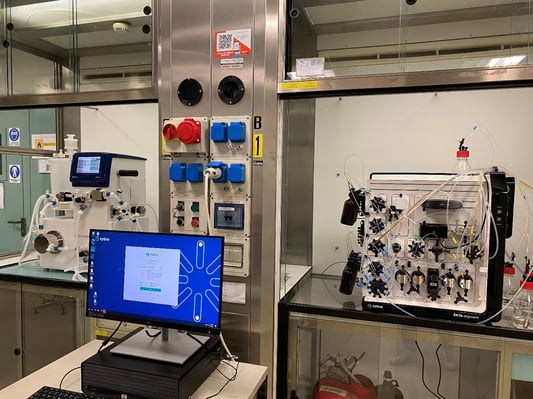Rapidly growing tumor cells need a lot of oxygen and nutrients to proliferate, which requires access to the bloodstream. Therefore, tumors induce the formation of new blood vessels through a variety of molecular mechanisms. In normal tissue, there is a delicate balance of pro- and anti-angiogenic factors. In cancers, a process known as the "angiogenic switch" is initiated. As a result, pro-angiogenic signaling becomes dominant, allowing tumors to induce anarchic blood vessel formation. This switch is a critical step in the rapid growth of malignant cells, accompanied by the formation of new blood vessels.
One of the most important initiators of angiogenesis is the family of pro-angiogenic vascular endothelial growth factors (VEGF) and their receptors (VEGFR), which play an important role in both physiological and cancer angiogenesis. All members of the VEGF family stimulate cellular responses by binding to specific tyrosine kinase receptors, the VEGFRs, on the cell surface, causing them to dimerize and become activated. While VEGF-A regulates angiogenesis and vascular permeability by activating VEGFR-1 and VEGFR-2, VEGF-B seems to play a role in the maintenance of newly formed blood vessels under pathological conditions, while VEGF-C and VEGF-D and their corresponding receptor VEGFR-3 regulate lymphangiogenesis, i.e., the formation of lymphatic vessels.
This critical involvement of VEGFRs and their associated signaling pathways in the orchestration of (lymph)angiogenesis makes VEGFRs attractive targets for the treatment of tumors and the prevention of metastasis. However, existing therapies targeting VEGFRs are not very specific and inhibit a broad spectrum of receptor tyrosine kinases including the entire VEGFR family, causing many side effects such as hypertension, proteinuria, hand-foot syndrome, anorexia, and fatigue. While they show good response rates and short-term efficacy, their impact on overall survival is limited, in part because side effects limit the effective dose. This also results in only partial or transient inhibition of VEGFR-3, allowing lymphangiogenesis to serve as a tumor escape mechanism.
Evotec and Kazia therapeutics has therefore started to develop more selective VEGFR-3 receptor tyrosine kinase inhibitors. Its lead candidate, EVT801, an orally available VEGFR-3 inhibitor, is not only highly selective for VEGFR-3, but also the only inhibitor known to inhibit both VEGFR-3 homodimers and VEGFR-3:VEGFR-2 heterodimers. The compound shows low nanomolar inhibitory activity and high selectivity over kinases, various receptors, and ion channels. In November 2022, Evotec scientists reported in Cancer Research Communications that EVT801 showed potent antitumor activity in various in vitro and in vivo models. Moreover, the compound's in vivo efficacy was at least as good as that of the marketed pankinase inhibitors sorafenib and pazopanib. However, unlike sorafenib, EVT801 did not increase blood pressure in monkeys during regulatory toxicology studies or in a rat model of hypertension at doses up to 500 mg/kg, an order of magnitude higher than the pharmacological doses.
The investigators also observed that EVT801 reduced tumor (lymph)angiogenesis, apparently affecting small tumor vessels more significant than larger ones.
The efficacy of EVT801 is expected to depend on the level of VEGFR-3 expression. Interestingly, expression level of VEGFR-3 did not appear to be affected by sorafenib treatment, suggesting that EVT801 could be used in patients previously treated with any VEGFR tyrosine kinase inhibitor. However, these findings need to be confirmed in clinical trials to determine the minimum threshold of VEGFR-3 expression for effective clinical application of EVT801 and for future patient stratification.
The proposed mechanism of action of EVT801 involves three sequential anti-cancer mechanisms, all of which contribute to the inhibition of tumor growth and metastasis:
- It prevents tumor growth by impairing both tumor angiogenesis and (lymph)angiogenesis, thereby stabilizing the tumor vasculature, reducing metastasis, and reducing hypoxia in the tumor microenvironment.
- It enhances anti-cancer immunity as reflected by a decrease in immunosuppressive cytokines and cells in the circulation and tumor environment.
- It promotes T-cell infiltration into the tumor, ultimately supporting an enhanced and long-lasting anti-tumor immune response.
Taken together, these studies demonstrate that EVT801 is a novel anti(lymph)angiogenic agent that selectively targets VEGFR-3, modulates the tumor microenvironment to induce tumor vasculogenesis (i.e., fewer and overall larger vessels), and enhances immunotherapy.
Based on these promising results, EVT801 was selected to enter clinical trials. It is currently being evaluated as a single agent in a Phase I trial (NCT05114668) sponsored by Kazia and managed by Evotec Clinical Operations. The first stage of this Phase I study is designed as an open‑label, dose escalation trial to assess the safety, tolerability, and pharmacokinetics of EVT801 in up to 48 patients with advanced solid tumors. Details of the study were presented at the AACR Annual Meeting 2023 (Orlando, FL) (Abstract #1015). This dose escalation part will be followed by a biomarker and pharmacodynamics expansion cohort (second stage), including patients with high VEGFR-3 expressing cancers. These study sections may then be followed by a second dose escalation study, in combination with cancer immunotherapies.
The plan is to establish a patient stratification based on VEGFR-3 expression assessed by immunohistochemical imaging and immunofluorescence on tumor tissues before and after treatment. To enable this patient stratification analysis in a clinical setting, Evotec has established and validated a highly specific protocol for VEGFR-3 immunohistochemistry labeling and scoring strategy that is readily transferable to clinical sites.
To refine the VEGFR3 immunohistochemistry signature and to improve patient characterization, Evotec has developed a VEGFR3 mRNA gene signature consisting of 23 genes highly correlated with VEGFR-3 expression. The gene signature will be analyzed using the Fluidigm platform on matched FFPE patient samples. The relationship of key markers at protein and mRNA level will be investigated to potentially establish biomarkers for patient stratification and selection.
We expect that the ambitious biomarker strategy will help to better understand the effects of EVT801 in humans and may also help to select the most responsive patients and provide early indications of clinical efficacy as a monotherapy (e.g. clear renal cell carcinoma, soft tissue sarcoma and ovarian cancer) or in combination with standard of care (e.g.immune checkpoint therapies). Evotec and Kazia recently presented a scientific poster on this topic.


